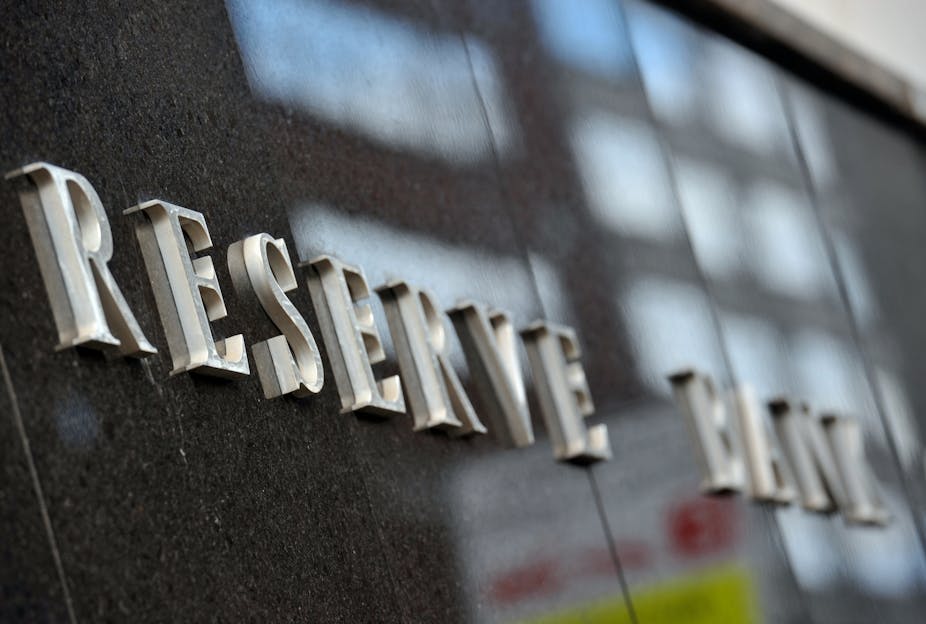The pressure is on Australia’s major banks to pass on the Reserve Bank of Australia’s 50 basis point cut in full to Australian households and businesses.
In a surprise move, the RBA slashed Australia’s cash rate by 50 basis points to 3.75%, amid data showing inflation is easing and signs of weakness in the housing market.
In his statement, RBA Governor Glenn Stevens cited moderating growth and China, and “difficult” conditions in Europe, although he said commodity prices remained little changed at off-peak, but “quite high” levels.
Mr Stevens also said wholesale funding costs at the margins had declined over recent months, though they remained higher than benchmark rates in mid-2011.
So will banks cut? Should they? And did the RBA move quickly enough? The Conversation spoke to three financial experts for their take on the decision.
Mardi Dungey, Professor of Economics and Finance at the University of Tasmania:
The big issue will be about whether the banks cut their mortgage rates. They won’t want to, as I suspect they are still under pressure from international funding, as events in Europe over the last couple of weeks signal that credit conditions have got a lot tougher again. The fact that the RBA has cut by this much in a single move signals that it is seriously concerned.
Most of the ANU Shadow Board members put most of the weight on a 25 basis point cut. We didn’t expect the RBA to cut so rapidly - but some of us did expect a cut last month; in aggregate there was a reasonable weight on cutting last month, so perhaps the RBA has decided to have more bang for its buck with a 50 point cut. It’s a very strong signal that we are no longer in a tightening phase and we are easing again.
My personal opinion is the RBA should have cut earlier. I think the signals have been there for a little while, especially out in the regions. It is going to take a little while to unwind some of the damage in the regions. But there are problems in trying to implement monetary policy effectively where a two speed economy problem exists, and monetary policy is a pretty blunt instrument to deal with that. In most of the regions there is a fair degree of fiscal rectitude. This is creating some serious problems, with the potential for sustained lower growth in a number of areas.
With a 50 basis point, the banks are going to be very hard-pressed not to cut anything out of their mortgage rates. From the RBA point of view falling mortgage rates are an important means of transmitting looser monetary policy to the economy via households.
Graham White, Senior lecturer, School of Economics at the University of Sydney:
The RBA does an estimate of the borrowing rates they think would be appropriate and what cash rate cuts would need to be to achieve that, taking into account the likely movements in funding costs for the major banks.
You’d expect the RBA is taking that account that the 50 basis points that they’ve chopped off the cash rate is going to lead to some easing in mortgage and business rates by banks.
Glenn Steven’s statement argues low inflation rate (of 1.6%) and the positive forecast over the next 18 months or so gives them a bit of room to move and to play with interest rates, in an economy where there is a lot of uncertainty about demand and activity in the economy.
But in terms of consumer behaviour, this is where the economics become even less uncertain. There is a view that lowering interest rates is a bit like pushing on a string - if there is enough uncertainty about the future, then you get consumer thinking, “I will pay out some debt, or I’ll save the extra mortgage relief and shove it in the bank for a rainy day” and you don’t get a bump in consumer demand. Perhaps this is the case with business also.
Business are also looking at sales growth and investment plans, so the question is whether the cut will do anything significant in terms of their investment decisions. For those selling overseas, if you’re not in the mining sector the outlook is even more uncertain and worrying, although some easing of interest rates may in turn take some pressure off the value of the Australian dollar.
Nigel Morkel-Kingsbury, Assistant lecturer, Department of Accounting and Finance at Monash University:
For banks, the key is going to be the deposit rate. Yes, international funding costs have come down, but there are still a few uncertainties about Europe, so they are still going to be higher for a little while yet. The banks will crunch their own numbers as to how much deposit funding they are likely to attract. If they can only attract deposits by offering 5.0% which is basically the same level as they are offering now, you might only just see a 25 basis point cut.

